Furniture Blog
Custom Furniture Gallery
Making the tambour door credenza
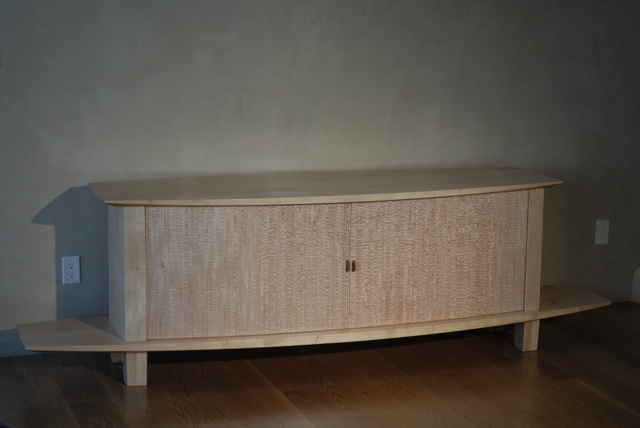
This custom maple credenza was built for a client of mine in Santa Fe. It has tambour doors (like a roll top desk, but they slide horizontally) that are made from curly maple. You can read about how the design process worked on this blog post about designing this custom credenza.
The construction process started with a full scale plan drawing of the inside of the cabinet which showed the track that the tambour doors ran in, the location of the interior dividers and the location of the false sides and false backs that hide the doors from view when they are open. The drawing also showed the shape and location of the routing template that I needed to route the tambour door dado.
 After milling the parts for the carcass, I glued up the top and bottom panels as well as the sides, dividers, etc and ran them all through my 36" Woodmaster drum sander to clean them up and give me a perfectly flat surface. Then I made my tambour dado routing template and screwed it to the bottom panel. At this point I leave the carcass parts square so that I have reference points to work from. The template screws to the panels in the location of the false sides so that the screw holes won't show later.
After milling the parts for the carcass, I glued up the top and bottom panels as well as the sides, dividers, etc and ran them all through my 36" Woodmaster drum sander to clean them up and give me a perfectly flat surface. Then I made my tambour dado routing template and screwed it to the bottom panel. At this point I leave the carcass parts square so that I have reference points to work from. The template screws to the panels in the location of the false sides so that the screw holes won't show later.
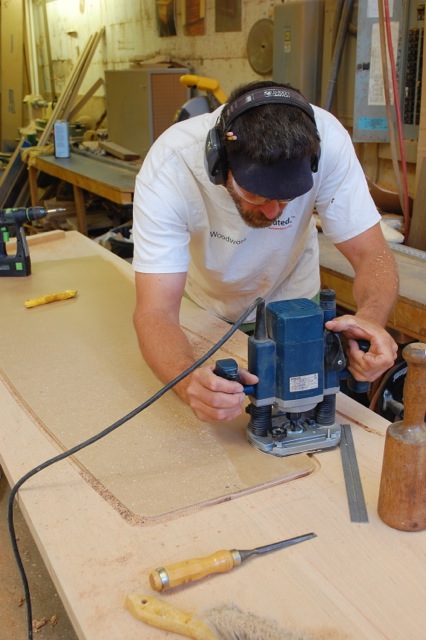 Once the template is on I can use a router with a rub collar and a 1/2" spiral bitt to route the tambour dado. I also run the dados for the false sides and backs on the inside of the top and bottom panels.
Once the template is on I can use a router with a rub collar and a 1/2" spiral bitt to route the tambour dado. I also run the dados for the false sides and backs on the inside of the top and bottom panels.
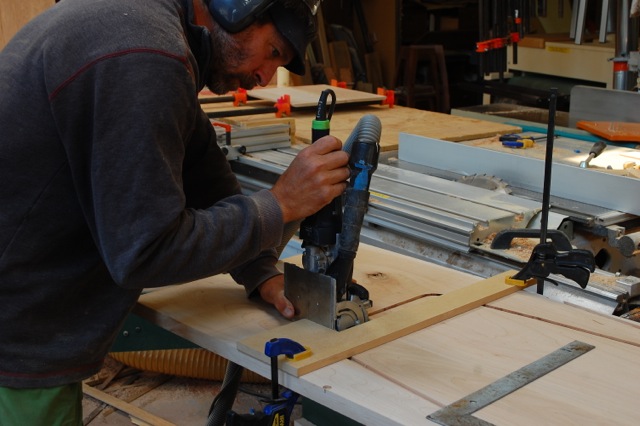 After the dados are run I use my Domino machine to plunge holes for attaching the sides.
After the dados are run I use my Domino machine to plunge holes for attaching the sides.
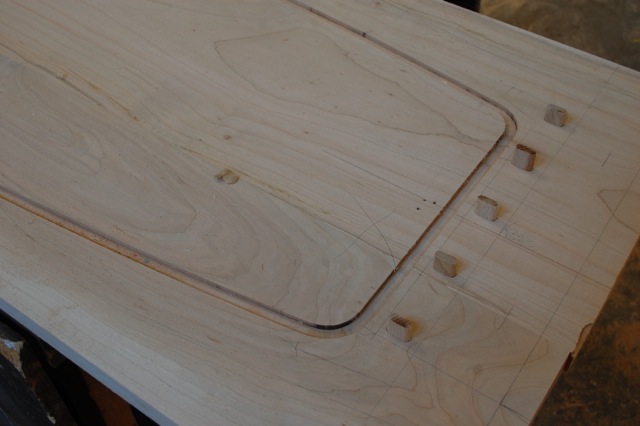 You can see the Dominos here, ready for the sides to be installed.
You can see the Dominos here, ready for the sides to be installed.
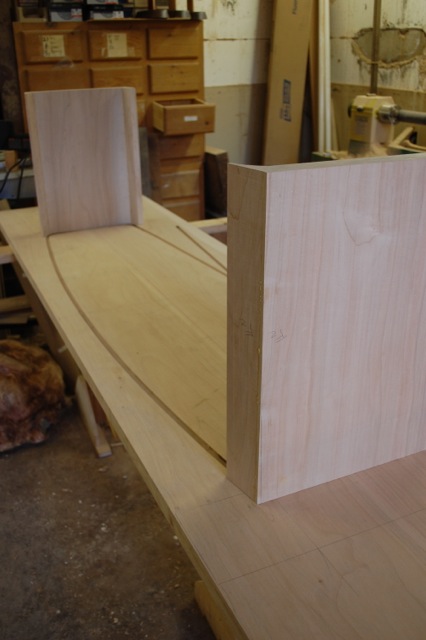 Here are the sides, with their mitered returns, set in place. The returns cover the curved part of the dado that the doors run in so that you don't see where they go as you open them.
Here are the sides, with their mitered returns, set in place. The returns cover the curved part of the dado that the doors run in so that you don't see where they go as you open them.
Since the tambour doors have to be able to come out of the back of the cabinet, the tambour dados cross in the back and exit the rear of the panel. You can see the dado heading out the back in this photo.
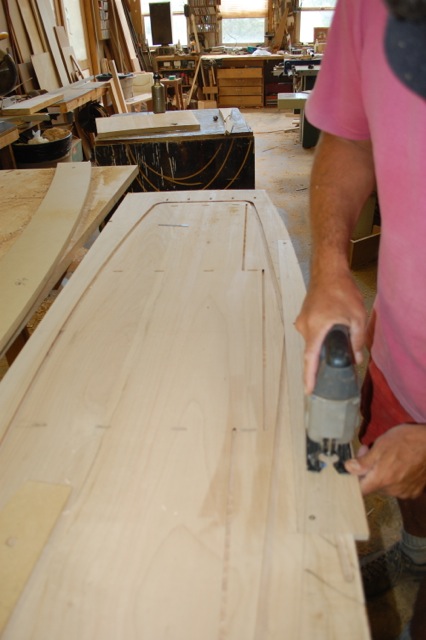 When all of the dados were routed and the Dominos plunged I made a panel to cover the door dados where they came out of the back of the cabinet. The back of the cabinet has an exposed ledge and I didn't want the dados showing there. After that panel was installed I cut the curves on the top and bottom panels with a jig saw and then routed them to a curved template. The panel was removed later for installation of the doors, then replaced.
When all of the dados were routed and the Dominos plunged I made a panel to cover the door dados where they came out of the back of the cabinet. The back of the cabinet has an exposed ledge and I didn't want the dados showing there. After that panel was installed I cut the curves on the top and bottom panels with a jig saw and then routed them to a curved template. The panel was removed later for installation of the doors, then replaced.
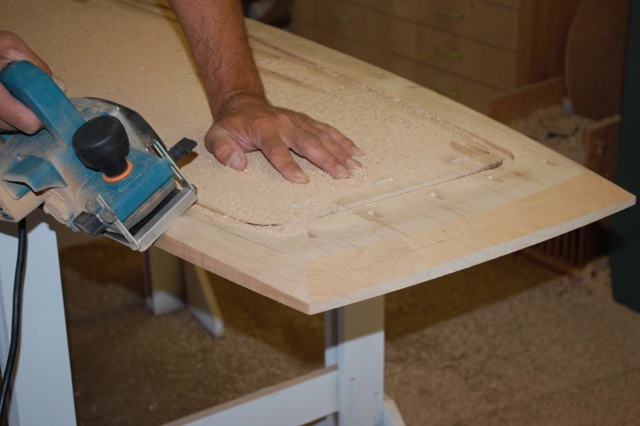 You can see in the photo at the top of this post that the underside of the top and bottom have a curve shaped on them. I used my Veritas curved sole power plane to cut that compound bevel. I pretty much just eyeball that detail. Then I finish it with my Festool random orbit sander. It also has an orbital mode that I use for operations like this since it really removes material and makes shaping fast and easy with a coarse grit.
You can see in the photo at the top of this post that the underside of the top and bottom have a curve shaped on them. I used my Veritas curved sole power plane to cut that compound bevel. I pretty much just eyeball that detail. Then I finish it with my Festool random orbit sander. It also has an orbital mode that I use for operations like this since it really removes material and makes shaping fast and easy with a coarse grit.
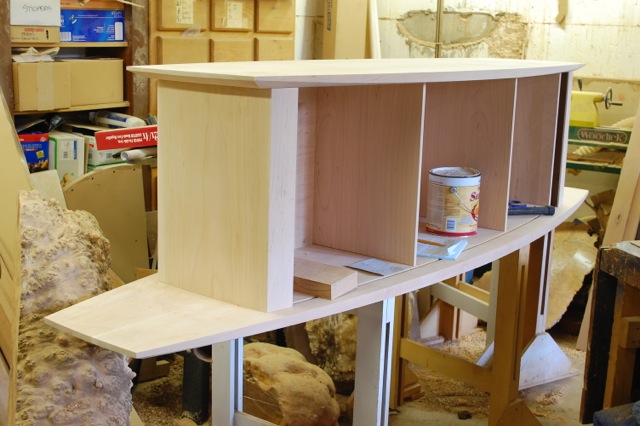 Here the cabinet is assembled and I'm in the process of finishing the places that will be inaccessible later with Seal Coat, which is a de-waxed shellac and is compatible with other finishes.
Here the cabinet is assembled and I'm in the process of finishing the places that will be inaccessible later with Seal Coat, which is a de-waxed shellac and is compatible with other finishes.
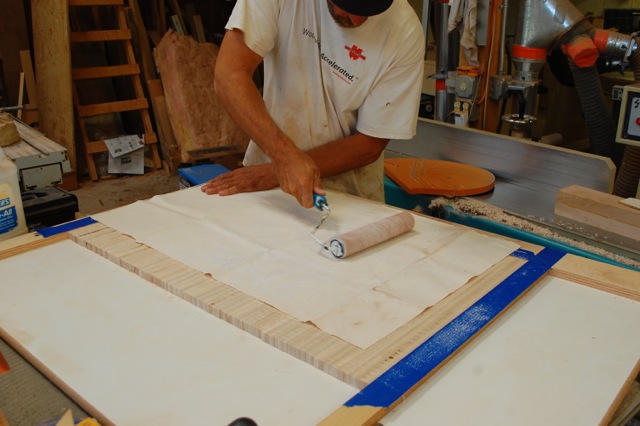 Usually tambour doors have some sort of profile milled onto the front of the tambour slats, but these doors were made from square stock and sanded smooth on the face. The curly maple for the door slats was ripped to size and put into the door panels randomly to give the doors a dappled, sparkly look. In this photo I've made a jig to hold the slats for glueing the canvas backs onto the doors and I'm rolling PVA glue onto the canvas. That fabric acts as a hinge between the slats and allows the doors to go around corners and retract when the doors are opened.
Usually tambour doors have some sort of profile milled onto the front of the tambour slats, but these doors were made from square stock and sanded smooth on the face. The curly maple for the door slats was ripped to size and put into the door panels randomly to give the doors a dappled, sparkly look. In this photo I've made a jig to hold the slats for glueing the canvas backs onto the doors and I'm rolling PVA glue onto the canvas. That fabric acts as a hinge between the slats and allows the doors to go around corners and retract when the doors are opened.
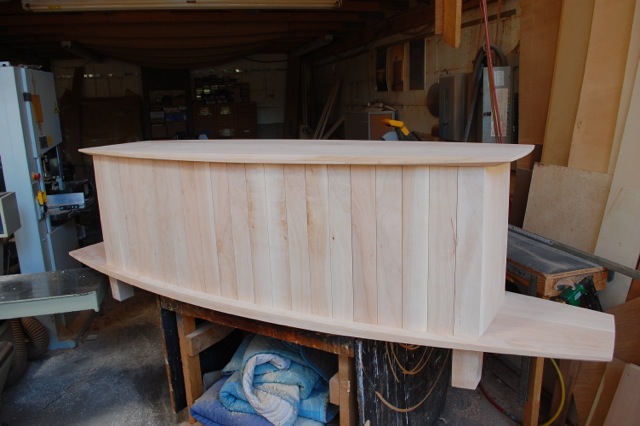 This is a view of the shiplap plank back. These planks have a rabbet milled on each edge so that they can overlap and you won't see light through the back as the planks change size with the humidity changes. The planks are simply nailed into a rabbet.
This is a view of the shiplap plank back. These planks have a rabbet milled on each edge so that they can overlap and you won't see light through the back as the planks change size with the humidity changes. The planks are simply nailed into a rabbet.
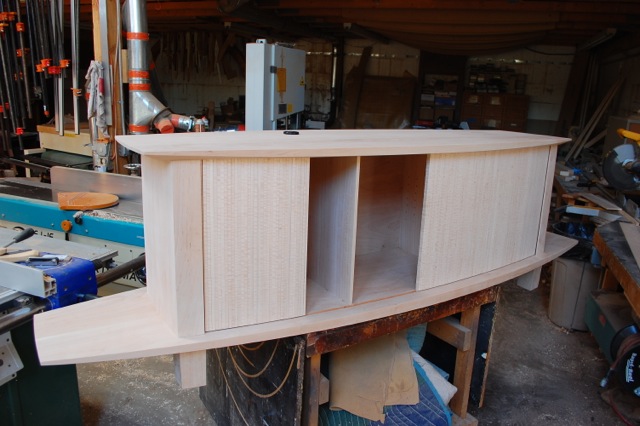 This is the cabinet before the finish went on. The doors are in for final fitting, but they come out for finish.
This is the cabinet before the finish went on. The doors are in for final fitting, but they come out for finish.
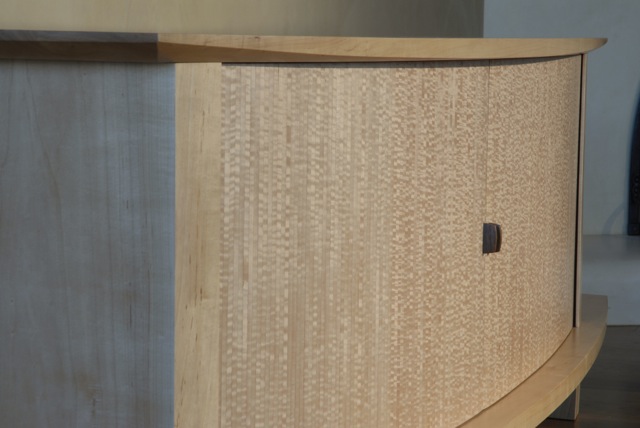 Here is a detail shot of the finished cabinet. You san see the stippled look that the curly maple gives as well as the rolling bevel that was cut on the underside of the top panel.
Here is a detail shot of the finished cabinet. You san see the stippled look that the curly maple gives as well as the rolling bevel that was cut on the underside of the top panel.
For a more detailed article on tambour doors check out my article in Fine Wood Working Magazine
You can read about how the design process worked in this blog post.








